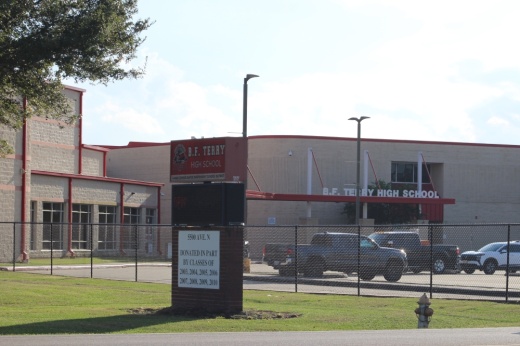Much like other LCISD campuses, Terry High neighbors its secondary sixth-grade and junior high campuses on the same site. The rebuilding will continue this model, Superintendent Roosevelt Nivens said.
Zooming in
Occupying nearly $500 million of the 2025 bond’s Proposition A—which aims to open new schools and fund facility repairs—the district’s “Relocating and Rebuilding: Red and Blue” plan begins with new construction at three red track campuses. Terry High, along with George Junior High and Navarro Middle schools, will move into the new facilities.
The existing buildings will serve as temporary locations for students from Lamar Consolidated High, Lamar Junior High, and Wessendorff Middle schools in the blue track, while those schools are rebuilt under the next bond in 2029.
The area in the middle of the red track, near the new Career and Technical Education Center on 59 Spur 10, is projected to receive tens of thousands of new homes in the near future. Moving Terry High to this central location allows the district to build a larger complex to support the incoming student population, Nivens said.
The new Terry High campus is expected to be completed by 2029, while the Lamar Consolidated High secondary complex is scheduled to return to its rebuilt campuses by 2032.
Why it matters
Nivens said since Terry and Lamar Consolidated high schools are "fairly close to proximity," with maps showing there is only about 1.5 miles in between, ongoing rezoning efforts could result in overlapping attendance zones.
To prevent this rezoning issue and manage future population growth, Nivens said the plan is to move the Terry High complex down to the middle of the red track near the incoming CTE campus set to open in fall 2026. Nivens said this area, which includes Kendleton and Emberly, is expected to see more growth.
The new Terry High complex is designed to be larger, helping the district accommodate growth and delaying the need to build additional secondary campuses later on. High school capacity would increase from 1,875 students to 3,100 students.
Chief Operating Officer Greg Buchanan said building new schools is more cost-effective than renovating outdated facilities and supports growing enrollment with modern, efficient spaces. He said this plan also minimizes the need for portable classrooms, which could cost the district up to $300,000 per portable.
The unoccupied Terry High complex will be turned into a specialized education academy, Nivens said, allowing the district to expand its choice offerings amid the growth of charter school enrollment in the district.
The timeline
Pending voter approval, the timeline for the projects includes:
- 2026: Construction begins on the new Terry High School complex, located at Spur 10 and Kiosternoff Road, near the existing CTE building
- 2029: Terry High secondary campuses relocate to the new facility; Lamar Consolidated High secondary campuses temporarily move into the former Terry High site while their new facilities are under construction
- 2032: Lamar Consolidated High's secondary campuses move into newly completed buildings along Mustang Avenue
- Post-2032: The former Terry High complex is repurposed as a specialized education center

Nivens said the plans to replace the red and blue track schools started last year during strategic planning, when parents voiced concern about the comparison between the newer complexes on the outskirts of the district that “didn’t look as good” as the older campuses.
Nivens said the district aims to provide equitable access to updated and modernized facilities across all attendance zones.
"I don't believe your ZIP code should determine the level of educational facilities that you have or ... your destiny,” he said during a Sept. 24 bus tour.
Previous renovations have totaled approximately $37.3 million for the Terry, George and Navarro campuses and $54 million for the Lamar High, Lamar Junior High and Wessendorff Middle campuses. The campuses, which are among the first built in the district, date back to the building of Lamar Consolidated High in 1949, when the district started, according to its website.
During the bus tour, district officials highlighted differences between the older Terry High campus in Rosenberg, built in 1982, and the Tomas High campus in Richmond, which opened this August. Officials noted key differences include:
- Layout and flow: Terry High has multiple hallways and stairwells that contribute to noise and make discipline management more difficult, while newer schools use centralized hallways and academic pods to reduce student movement.
- Common areas: Terry’s cafeteria is enclosed and has a smaller kitchen and storage spaces, requiring more staff. Newer campuses feature open common areas.
Another thing
Additionally, Proposition A includes funding for roof and heating, ventilation and air conditioning upgrades at 42 sites, as well as improvements to older district buildings, including those used by the technology department, Buchanan said.
HVAC and roofing projects included in the 2025 bond are part of the district’s regular replacement schedule, addressing systems that are at or beyond their expected lifespan. Similar projects are anticipated in future bonds as part of ongoing facility maintenance across district campuses, Buchanan said.
Moving forward
Nivens said earlier proposals for older campuses—including Travis and Jane Long elementary schools—were faced with rejection by the community, which preferred to keep existing older buildings.
However, he said the district needs to have a "different conversation with the community on how we address older campuses, with newer campuses, and not just renovations."
The final bond vote will take place Nov. 4, officials said.





